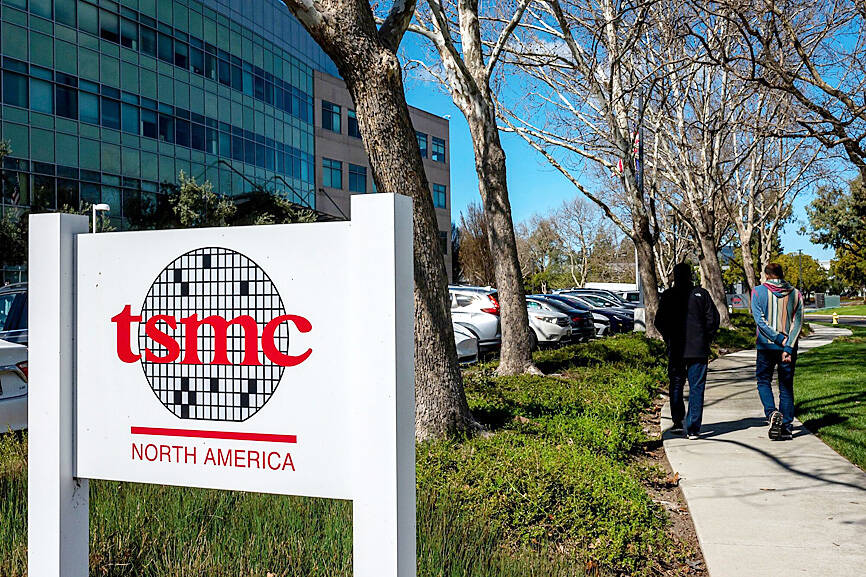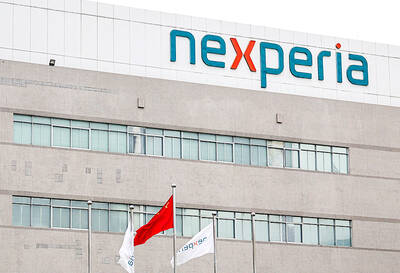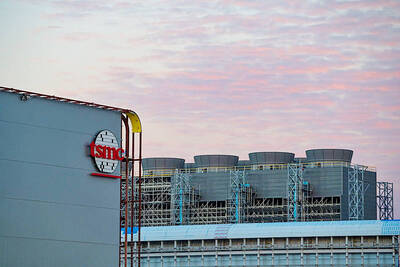Taiwan Semiconductor Manufacturing Co (TSMC, 台積電) retained its top position in the global wafer foundry business in the fourth quarter of last year and widened its lead over second-placed Samsung Electronics Co, TrendForce Corp (集邦科技) said in a report on Monday.
TSMC posted US$26.85 billion in sales in the October-to-December period, up 14.1 percent from the previous quarter, which lifted its market share to 67.1 percent, up from 64.7 percent in the prior quarter, the Taipei-based market researcher said.
In contrast, Samsung’s sales fell 1.4 percent sequentially to US$3.26 billion last quarter and its market share slid to 8.1 percent from 9.1 percent over the period, the report said.

Photo: Bloomberg
That widened the gap between the two companies to 59 percentage points last quarter from 55.6 percentage points a quarter earlier.
TrendForce attributed TSMC’s growth to persistent demand for artificial intelligence (AI)-related chips and advanced packaging services, in addition to steady orders for chips used in high-end smartphones and new PC platforms.
Meanwhile, Samsung’s revenue fell as order gains from new clients for advanced-node chips did not fully offset declines in orders from major existing clients due to rising competition in mature nodes from Chinese rivals, the report said.
China’s Semiconductor Manufacturing International Corp (中芯) came in third with US$2.21 billion in revenue last quarter and a market share of 5.5 percent, narrowing its gap with Samsung to 2.6 percentage points from 3.1 percentage points in the previous quarter, the report said.
United Microelectronics Corp (聯電) ranked fourth with US$1.87 billion in revenue and a 4.7 percent market share, ahead of US-based GlobalFoundries Inc with US$1.83 billion in revenue and a 4.6 percent market share, the report showed.
In sixth to 10th places were China’s Huahong Group (華虹) with US$1.04 billion in revenue and a 2.6 percent market share; Israel’s Tower Semiconductor Ltd with US$387 million and 1 percent market share; Vanguard International Semiconductor Corp (世界先進) with US$357 million and 0.9 percent; China’s NexChip Co (晶合集成) with US$344 million and 0.9 percent; and Powerchip Semiconductor Manufacturing Corp (力積電) with US$333 million and 0.8 percent, the report added.
The combined revenue of the top 10 wafer foundry companies reached a fresh record high of US$38.48 billion last quarter, up 9.9 percent from US$35.01 billion in the previous quarter, as strong demand for advanced-node chips for AI servers, flagship smartphone application processors and new PC platforms helped offset the slowdown in demand for mature-node chips, TrendForce said.
As the industry’s momentum remains largely unchanged, overall foundry revenue this quarter is forecast to decline slightly from last quarter, despite the beginning of a year being a seasonally weak quarter for foundries, TrendForce added.

JITTERS: Nexperia has a 20 percent market share for chips powering simpler features such as window controls, and changing supply chains could take years European carmakers are looking into ways to scratch components made with parts from China, spooked by deepening geopolitical spats playing out through chipmaker Nexperia BV and Beijing’s export controls on rare earths. To protect operations from trade ructions, several automakers are pushing major suppliers to find permanent alternatives to Chinese semiconductors, people familiar with the matter said. The industry is considering broader changes to its supply chain to adapt to shifting geopolitics, Europe’s main suppliers lobby CLEPA head Matthias Zink said. “We had some indications already — questions like: ‘How can you supply me without this dependency on China?’” Zink, who also

Taiwan Semiconductor Manufacturing Co (TSMC, 台積電) received about NT$147 billion (US$4.71 billion) in subsidies from the US, Japanese, German and Chinese governments over the past two years for its global expansion. Financial data compiled by the world’s largest contract chipmaker showed the company secured NT$4.77 billion in subsidies from the governments in the third quarter, bringing the total for the first three quarters of the year to about NT$71.9 billion. Along with the NT$75.16 billion in financial aid TSMC received last year, the chipmaker obtained NT$147 billion in subsidies in almost two years, the data showed. The subsidies received by its subsidiaries —

At least US$50 million for the freedom of an Emirati sheikh: That is the king’s ransom paid two weeks ago to militants linked to al-Qaeda who are pushing to topple the Malian government and impose Islamic law. Alongside a crippling fuel blockade, the Group for the Support of Islam and Muslims (JNIM) has made kidnapping wealthy foreigners for a ransom a pillar of its strategy of “economic jihad.” Its goal: Oust the junta, which has struggled to contain Mali’s decade-long insurgency since taking power following back-to-back coups in 2020 and 2021, by scaring away investors and paralyzing the west African country’s economy.

The number of Taiwanese working in the US rose to a record high of 137,000 last year, driven largely by Taiwan Semiconductor Manufacturing Co’s (TSMC, 台積電) rapid overseas expansion, according to government data released yesterday. A total of 666,000 Taiwanese nationals were employed abroad last year, an increase of 45,000 from 2023 and the highest level since the COVID-19 pandemic, data from the Directorate-General of Budget, Accounting and Statistics (DGBAS) showed. Overseas employment had steadily increased between 2009 and 2019, peaking at 739,000, before plunging to 319,000 in 2021 amid US-China trade tensions, global supply chain shifts, reshoring by Taiwanese companies and